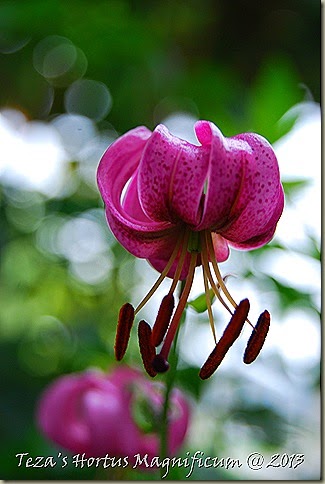
Without a doubt, one of the daintiest, and beautiful of our North American wildflowers, is Erythronium, also known as dog tooth violet. [an epithet given due to the canine incisor shape of their corms.] I vividly remember, during my weekend treks through the ‘Darkling Wood’ with my Grandparents, stumbling upon patches of wonderful mottled foliage, topped with lily like blooms of the brightest yellow! Little did I know then that I was witnessing the native Erythronium americanum.
Erythronium inhabit deciduous forests at higher elevations in open meadows that receive consistent early-Spring sunlight. They do not tolerate much shade, and require fairly cool, consistently moist soils with a pH of 5-6. In a garden setting, they are happiest in an open site with some sun in a light or dappled woodland shade. Eastern North American species are tolerant of more shade, but are also fickle in flowering!
Most flowering sized plants have two leaves, with a slim flower stalk that is notably curved towards the tip, where the flower emerges. Flowers usually consist of three recurving petal-like sepals, and three recurving petals, giving them a lily like appearance. In a fully recurved [reflexed] position, they are reminiscent of delicate crowns! Simply breathtaking!
Most flowering sized plants have two leaves, elliptical, basal and erect. They are usually a shiny dark green mottled with brownish to grey brown colorations. Unfortunately the genus has a reputation for being difficult to grow. While some are considered ‘snowmelt’ plants, requiring special conditions, many are perfectly amenable to cultivation in well draining, humus rich soil on the woodland floor, or similar siting. It should be stated that the corm have no protective tunic, and such, are highly vulnerable to changes in humidity. As a result, they need to be planted deeper than one would expect, as shallow planting often leads to desiccation in dry summers. Never allow the corms to dry out completely. If you are purchasing corms, always check to ensure that moistness is present, otherwise, you’re likely to be heartbroken the following Spring. [Been there, done that!] I would strongly suggest purchasing corms and or plants from a specialist grower when at all possible. Most within the genus are hardy between Zones 3-6, making it an advantageous addition to northern gardens!
Aside of the beautiful yellow flowered native, there are wonderful Asian species that are garnering their fair share of attention. Erythronium dens canis is an endearing European species that is tolerant of slightly moister conditions than it’s North American cousins. Overall it is lower growing, but with smaller bulbs, it produces offsets freely, clumping up at a relatively enviable rate! Pink flowers are held above beautifully mottled foliage
Erythronium revolutum is arguably the best and loveliest within the genus for naturalizing, as it has a reputation for seeding itself most liberally! My personal favourite is Erythronium hendersonii, a staggering beauty that, while difficult to ascertain within hort commerce, is well worth the search and dent to your pocketbook! The photo prefacing this post, as well as this last one are of said species. This diminutive, darling genus is definitely worthy of a closer, on hands and knees, investigation! Don’t let their temperamentality stop you from experimenting with them in your woodland garden – they are so well worth any and all risk and effort!




































2 comments:
I've had Erythronium americanum growing in my garden for over a decade and it has never bloomed. I know they are still there as they send up foliage every year. I'm told that they "find their own depth" eventually, but this has never happened, yet.
The west coast hybrid 'Pagoda', on the other hand, does really well and may be the easiest to grow.
I also grow Erythronium americanum but am fortunate to have some blooms. It spreads well on its own but like Barry said you get a lot of one leafed foliage. Last year I had 4 or 5 flowers amongst (I'm guessing) 40 plants.
Post a Comment